My Bird Page


This page is dedicated
to the fowl that I personally raise at "Red Cedar River Bird and Game Farm". Some species are not represented at this time.
They soon will be.

The Temminck Tragopan
(Tragopan Temmincki) is one of my favorite species.
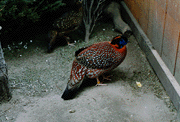
Picture courtesy of David Noel.
Click on this image to view a larger
version of this Temminck and other pictures.
I have only been raising
Temmincks for a few years but I believe it to be one of the
nicest colored species that I raise. It takes two years to
achieve their adult plumage but it is well worth the wait. This
is one of the most fascinating pheasants when displaying, during
breeding season. Their lappets and skin horns are inflated
creating a very dramatic effect. The hen will normally lay 4 to 5
eggs per clutch which are incubated for 28 days.
Their diet has been suggested as primarily vegetarian with a lot
of fruit and berries but they do quite well on gamebird pellets,
fed free choice, with added fruits and greens. They should be
provided with adequate shade in their pens, in warmer climates,
they appear to be heat sensitive.
The Elliot's Pheasant (
Syrmaticus Ellioti ) is another very striking pheasant that I
raise.
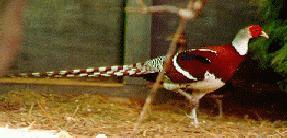
Picture courtesy Don Arndt's site/with
permission
The Elliot's pheasant is
also a very beautiful bird. It has red wattles around the eyes
with a whitish-gray neck. Part of it's back feathering has a
metallic golden brown sheen that is spectacular when viewed with
the sun striking it. It is one of the long tailed pheasants which
achieve their adult plumage the first year. They are a hardy
species and lay quite well in captivity, although the cocks can
be very mean to the hens. It is advisable to have plenty of
shrubs or branches in the pens to allow the hen cover to escape.
The hen will normally lay 6 to 8 eggs which are incubated for 25
days. They are quite happy with a gamebird pellet feed.
The Reeves' Pheasant (
Syrmaticus reevesi ) is another pheasant that I take pride in
raising.
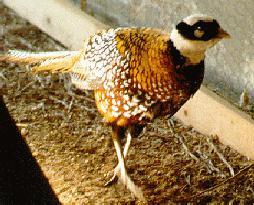
Picture courtesy of Don Arndts site/with
permission
The Reeves' Pheasant is a
pheasant that I have taken a particular interest in. The tail of
the cock bird can grow to a length of five feet. When observing
them they seem to me to be a water coloring, the blacks,
whites,and bronzes just appear to flow together as such. I have
been told that most specimens are rather inbred, (not surprising
being that they are one of the the most popular of the common
pheasant in captivity), and that is the supposed reason for the
black feathers speckling the top of the head. The Reeves'
pheasant has been released in many areas and has survived well,
establishing a new species to the area of release. They are also
bred to be a huntable resource on game reserves, probably adding
to the the fact of being inbred. Myself and a few other persons
are trying to breed only completely non related species to return
to the absolute pure white head feathering. This species attains
full adult plumage the first year. The hen will normally lay 7 to
14 eggs and incubate them for 25 days. They get along fine on a
normal pheasant diet of gamebird pellets with a little grain as a
daily treat.
The Silver Pheasant (
Lophura nycthemera ) has long been popular with many
aviculturists.
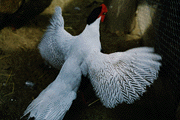
Picture courtesy of David Noel.
Silver male drumming during courtship
display.
Click on the image to view a larger version
of this Silver pheasant.
The Silver pheasant is
also a very fine looking bird with the black penciling of the
snow white back and tail feathering, the large red wattles
surrounding the eyes, and the blackish head and breast feathers.
There are thirteen recognized subspecies, all of which bear close
similarities. The True Silver Pheasant, (L. n. nycthemera), being
the most numerous in North America. This species attain their
adult plumage the second year. The hen will lay 4 to 6 eggs and
incubate them for 25 to 26 days. They will also do fine on a
normal pheasant diet of gamebird pellets. Mine also like a little
daily grain as a treat.
The Lady Amherst
Pheasant ( Chrysolophus amherstiae ) is one of the most
beautiful, of the commonest pheasants.
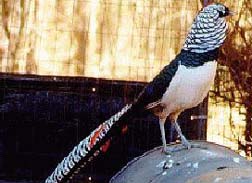
Picture courtesy of Don
Ardnt's site/with permission
The Lady Amherst Pheasants
is a very spectacularly colored bird. It is classified as a
ruffed pheasant but it to can have a fairly long tail. It is a
very popular pheasant, reportedly second only to the Red Golden,
as an aviary species. I really like the contrasting coloring of
this bird. The only problem I have with this species is the
hybridization that has taken place, making it a chore to find
genetically pure specimens. This species attains full adult
plumage the second year. The hen will lay 6 to 12 eggs which she
will incubate for 22 days. They fair well on a normal pheasant
diet, of gamebird pellets, with a little daily grain as a treat.
India Peafowl ( Pavo
cristatus ) is another pheasant species that we now
raise.
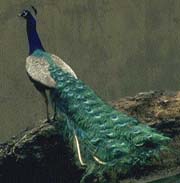
Picture courtesy of Don
Arndt's site/ with permission
The India, or Blue
Peafowl, is also a very beautiful bird. They are a very large bird and require a large aviary if
they can not be at liberty. They also have a harsh, strident
call, which carries a long way, particularly in the breeding
season. They attain their adult plumage the third year. The hen
will normally lay 4 to 8 eggs and incubate them for 27 to 29
days. They do well on a regular pheasant diet of gamebird
pellets. I also like to feed a little cracked grain as a treat.
They like to forage eating grasses, seeds, and any bugs that
come along.
Mandarin ducks ( Aix
galericulata ) are one of the wild waterfowl species that I
raise.
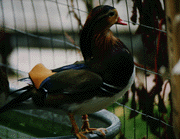
Picture courtesy of David Noel.
Click on this image
to view a larger version of this Mandarin and other pictures.
Mandarin ducks are one of
my favorite species of wild waterfowl. The Mandarin duck is a
native of eastern Asia where it is found mainly in China and
Japan. The Mandarin drake has an amazing and striking plumage
which makes him one of the most beautiful and striking ducks in
the world. They are a fairly small duck with a short bill and a
large head set on a stout neck. They are a perching duck and
prefer to nest in cavities of trees. Nest boxes must be hung in
pens for the captive raised mandarins. They will also require a
swimming water source of some type, a pond, a child's swimming
pool, or a horse watering trough works well. The hen of this
species will lay 9 to 12 eggs and incubate them for 28 to 33
days. Mandarins also do well on a diet of gamebird pellets with
greens and some grain fed daily.


 Persons have visited this page since Nov. 22 1998.
Persons have visited this page since Nov. 22 1998.

If you have enjoyed this site, please take a moment to sign the
guestbook at the bottom of my home page.
Use your back button to
return to my home page or click the link below.
![]()
![]()
![]()



![]()
![]()
Persons have visited this page since Nov. 22 1998.
![]()